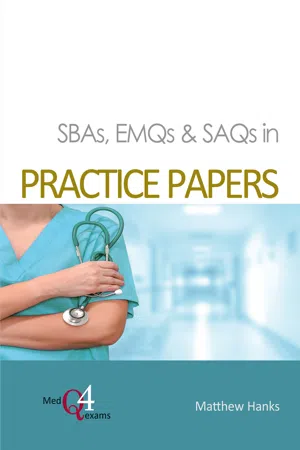
- English
- ePUB (mobile friendly)
- Available on iOS & Android
About This Book
SBAs, EMQs & SAQs in PRACTICE PAPERS provides a broad range and style of questions, not only for medical students preparing for their final exams, but also for clinicians preparing for their postgraduate exams. This book includes over 40 single best answer questions (SBAs), 140 extended matching questions (EMQs) and 25 short answer questions (SAQs), giving the reader a wide variety of topics to test their exam knowledge and technique. The book also includes a variety of radiological images (abdominal and chest X-rays), ABGs and ECGs for interpretation. It is an invaluable educational resource for exam preparation and to help you succeed. Key features: • Over 200 questions on the core medical subjects. • Compiled by a team of junior doctors with recent final exam and postgraduate specialty exam experience. • Overseen by experienced doctors to ensure relevance and accuracy. • The broad medical curriculum is covered in a succinct and consistent style. • Pharmacology and pathology are integrated throughout the text. • Clear and concise answers are provided. • Easy accessible information to facilitate revision on the move. • Enables the reader to assess their knowledge and help identify gaps in their knowledge to target revision. • The following main specialties are covered: Breast surgery; Cardiology; Dermatology; Endocrinology; ENT surgery; Fluids & electrolytes; Gastroenterology; Haematology; Infectious diseases; Lower gastrointestinal surgery; Neurology; Neurosurgery; Obstetrics & gynaecology; Oncology; Ophthalmology; Paediatrics; Psychiatry; Renal medicine; Respiratory medicine; Rheumatology; Statistics; Trauma & orthopaedics; Upper gastrointestinal surgery; Urology; Vascular surgery. • Watch out for our other titles in the MedQ4exams series: Medicine. Surgery. The Specialties
Frequently asked questions
Information
Section 1
Questions
Chapter 1
Practice paper 1
QUESTIONS
Single best answer questions
Table of contents
- Cover
- Title Page
- Copyright Page
- Contents
- About the Editor
- Contributors
- Acknowledgements
- Normal reference values
- Abbreviations
- SECTION 1: QUESTIONS
- SECTION 2: ANSWERS